Navigation
Install the app
How to install the app on iOS
Follow along with the video below to see how to install our site as a web app on your home screen.
Note: This feature may not be available in some browsers.
More options
You are using an out of date browser. It may not display this or other websites correctly.
You should upgrade or use an alternative browser.
You should upgrade or use an alternative browser.
Updated! - Test Your Diagnostic Skills - Warning, Contains Graphic Necropsy Photos
- Thread starter casportpony
- Start date
- Thread starter
- #372
@Jspenc02 , my apologies, I forgot to say I'm sorry for your losses. 
As was already mentioned, based on the excess fat on all of the organs and in the belly, as well as the color of the friable liver, my best guess would be fatty liver disease.
This is a disease I know very little about. From what I just read there are a few thing that can cause it, one of those being aflatoxins.
From what I just read there are a few thing that can cause it, one of those being aflatoxins.
Thanks again for sharing, and so sorry for losses.

As was already mentioned, based on the excess fat on all of the organs and in the belly, as well as the color of the friable liver, my best guess would be fatty liver disease.
This is a disease I know very little about.
 From what I just read there are a few thing that can cause it, one of those being aflatoxins.
From what I just read there are a few thing that can cause it, one of those being aflatoxins.Thanks again for sharing, and so sorry for losses.
It is worth mentioning in case others are not aware of the original post, but @Jspenc02 has lost 3 birds in recent days, with similar symptoms, so this is sadly not a one off situation.
If it is dietary, it is quite surprising that they have died in such a short space of time. I'm not familiar with the aflatoxin link and wonder if it would also produce the thick deposits of fat or if it would just cause the liver to break down and haemorrhage. I'm assuming aflatoxins would result from mouldy/rancid food.... I know that nuts can be a source of aflatoxins in humans. (I used to work in a public analysts laboratory many years ago.)
If it is dietary, it is quite surprising that they have died in such a short space of time. I'm not familiar with the aflatoxin link and wonder if it would also produce the thick deposits of fat or if it would just cause the liver to break down and haemorrhage. I'm assuming aflatoxins would result from mouldy/rancid food.... I know that nuts can be a source of aflatoxins in humans. (I used to work in a public analysts laboratory many years ago.)
- Thread starter
- #374
Thanks for clarifying this.That mass is an unlaid egg. When I removed it the other two yolks along with some blood clots were visible. I did wash her out because the yolks were making a mess.
Kathy, Barbara - good point.
I did not realize 3 birds had been lost so quickly. I do wonder if it would be beneficial for @Jspenc02 to have a sampling of the feed they use tested by their state lab.
http://www.thepoultrysite.com/diseaseinfo/58/fatty-liver-haemorrhagic-syndrome/
http://www.thepoultrysite.com/diseaseinfo/100/mycotoxicosis/
http://www.merckvetmanual.com/poultry/mycotoxicoses/overview-of-mycotoxicoses-in-poultry
@Wyorp Rock That is a very good idea although reading through the link Kathy posted there is no mention of fatty deposits other than in the liver itself as a result of aflatoxin poisoning.
Below is an extract from that link
Clinical signs
Below is an extract from that link
Clinical signs
the most economically significant effects in growing birds are decreased growth rate and poor feed conversion because metabolites of aflatoxins bind to DNA and RNA of the cells and hence reduce protein synthesis
The OP states clearly in his original post that the birds grew well and were a good weight.... which seems to be the opposite of what aflatoxin poisoning would cause from that "clinical signs" quote indicates and suggests it may still be dietary afterall.
How much scratch was being fed and from what age might be very relevant still, because I would very much doubt that those fatty deposits occurred over the period of a couple of weeks.
How much scratch was being fed and from what age might be very relevant still, because I would very much doubt that those fatty deposits occurred over the period of a couple of weeks.
The food I was feeding is gone now. I switched to the runnings brand, which I think is made by nutrena. Food 10 birds I was feeding about .5-1 lbs of scratch grains to them a day. They consistently received scratch after about 13 weeks old. Should I feed a higher protein content feed like starter?
@Wyorp Rock That is a very good idea although reading through the link Kathy posted there is no mention of fatty deposits other than in the liver itself as a result of aflatoxin poisoning.
Below is an extract from that link
Clinical signs
the most economically significant effects in growing birds are decreased growth rate and poor feed conversion because metabolites of aflatoxins bind to DNA and RNA of the cells and hence reduce protein synthesis
Birds may have had a good growth rate - I would think a lot depends on at what age they encountered Aflotoxins/Mycotoxins.
excerpts from the links I provided
----------------------------------------
http://www.thepoultrysite.com/diseaseinfo/58/fatty-liver-haemorrhagic-syndrome/
Fatty Liver Haemorrhagic Syndrome
Extracted From:
A Pocket Guide to
Poultry Health
and
Disease
By Paul McMullin
© 2004
Introduction
A condition occurring worldwide in chickens, especially caged layers and with a complex set of causes including excessive calories, mycotoxins, deficiency and stress.
Post-mortem lesions
- Liver yellow, greasy and soft with numerous haemorrhages.
- Death by internal exsanguination after rupture of haematocyst.
Lesions, history.
Treatment
Reduce energy intake, supplement with choline, vitamin E, B12 and inositol.
Prevention
Feed to avoid obesity, avoid mycotoxins and stress.
_____________________________________________________________
http://www.thepoultrysite.com/diseaseinfo/100/mycotoxicosis/
Mycotoxicosis refers to all of those diseases caused by the effects of toxins produced by moulds.
Once toxins have been formed it is difficult to avoid their biological effects; they also increase susceptibility to bacterial diseases. Both fungal spores and formed toxins are generally highly resistant. Affected flocks return to normal mortality by 7 to 15 days after removal of the toxins. Some believe that mycotoxicosis is an important factor in fatty liver syndrome.
____________________________________________________
The food I was feeding is gone now. I switched to the runnings brand, which I think is made by nutrena. Food 10 birds I was feeding about .5-1 lbs of scratch grains to them a day. They consistently received scratch after about 13 weeks old. Should I feed a higher protein content feed like starter?
Scratch grains are considered a treat, imho.
A good rule to follow - treats should be no more than 5-10% of daily intake. Scratch grains are usually fairly low in protein, but can pack on the pounds (like candy).
Cut the scratch drastically and continue with the layer feed. You can also use a higher protein feed like non-medicated chick starter or flock raiser if that's what you wish to do, just offer oyster shell free choice.
I love to give my girls treats, but they don't free range, so I try very hard not to be heavy handed with something like scratch. Some other things you can do that may make yours happy is to hang a bundle of kale, cabbage, apple, etc. in the run to occupy them. I try to keep them busy, so rake up pine needles or even their straw into a pile - sometimes I mix finely chopped greens, broccolli or veggies to the pine needles/straw - this way they have to dig and hunt for bits of goodies. I feel like it gets them moving and I take pleasure in watching them scratch and hearing the little noises they make when they find something good.
I'm so very sorry that you have lost 3 of your ladies. I think tweaking the diet will be helpful.
Treerooted
Crowing
Hi, seeing if I can get some insight into my bird's death.
Speckled Sussex was 10 months old. I observed no symptoms until I found her laying under the roost, barely conscience. She died only a couple hours afterward.
She was secreting watery discharge from her cloaca which was tinged red. That thread is here: https://www.backyardchickens.com/threads/chicken-dying-sleeping-not-alert.1221972/
I know this is not proper necropsy technique, but we're just feeling tired tonight and needed to at least take a look inside and see if there was anything obvious.
Again, sorry for the shotty job. Also forgot to check the mouth and neck. I don't believe she had anything in her crop.
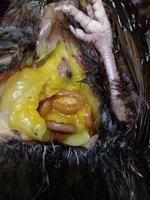
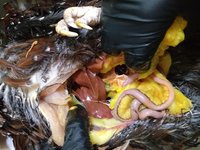
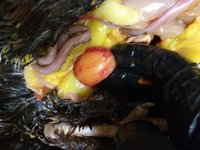
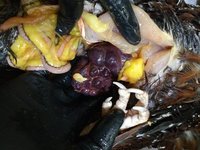
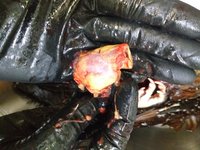
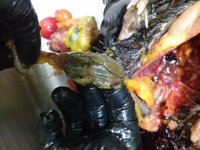
Speckled Sussex was 10 months old. I observed no symptoms until I found her laying under the roost, barely conscience. She died only a couple hours afterward.
She was secreting watery discharge from her cloaca which was tinged red. That thread is here: https://www.backyardchickens.com/threads/chicken-dying-sleeping-not-alert.1221972/
I know this is not proper necropsy technique, but we're just feeling tired tonight and needed to at least take a look inside and see if there was anything obvious.
Again, sorry for the shotty job. Also forgot to check the mouth and neck. I don't believe she had anything in her crop.






New posts New threads Active threads
-
Latest threads
-
-
My favorite duck just died, only you will understand the feeling
- Started by ILoveMyDucks123
- Replies: 1
-
-
Corid in a metal water container?
- Started by CCsGarden
- Replies: 6
-
-
-
Threads with more replies in the last 15 days
-
-
-
IN DEDICATION OF BILL GATES (I AM MAKING THIS THREAD ON @LOGARS WISH)
- Started by DaffytheDuck20
- Replies: 328
-
-
🐀 ~ Chronicles of Narnia RP What Happened after The Last Battle? ~ ⚔️
- Started by DaffytheDuck20
- Replies: 116
-
×



